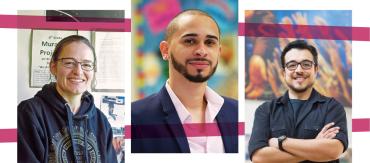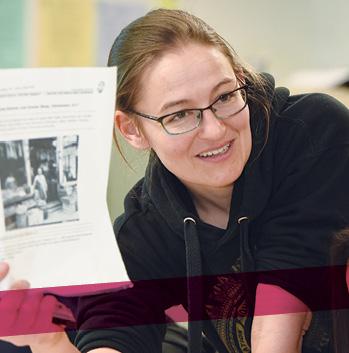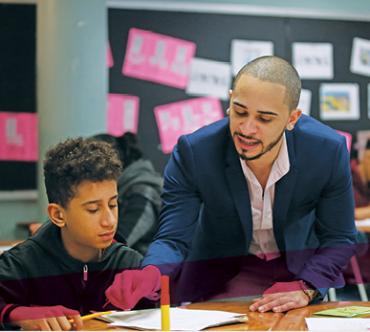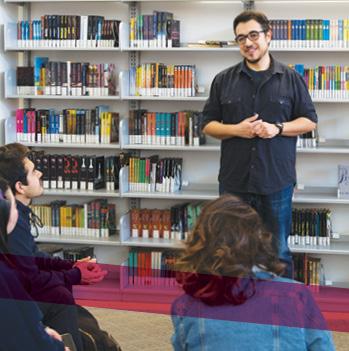Jennifer, Yancy, and Jason teach and learn at thriving community schools in San Francisco, New York, and Los Angeles, respectively. Their experiences challenge traditional ideas about what it means to learn and be a teacher. In their schools, teaching is a community effort where all the adults—teachers, social workers, parents, afterschool coordinators, mentors, and others—in students’ lives contribute to their learning and development. As teachers, Jennifer, Yancy, and Jason embrace their role as one of many—united in disrupting long-standing educational inequities. Sharing their experience helps us answer three questions facing the growing community schools movement: What does it mean to be a community school teacher? How do teachers in community schools promote deeper learning for students? And how does collaborative leadership create sustainable and humane community school workplaces?
Too often, community schools are solely portrayed as a reform to provide wraparound services for students without adequate attention to the foundational role that educators play in creating and sustaining these schools. We wrote this article to elevate the often overlooked role of classroom teachers in the community schools movement.
Understanding the Community Schools Concept
Community schooling is a concept with broad appeal and a long history dating back to Jane Addams and John Dewey. As neighborhood hubs, community schools bring together families, educators, and community partners to provide all the opportunities and services young people need to thrive. The most recent reform wave launched in 1997 with the Harlem Children’s Zone—a comprehensive, place-based anti-poverty initiative that established federally funded Promise Neighborhoods across the United States.
Since then, the growth of charter schools and the epidemic of neighborhood school closures have complicated the community schools landscape. For example, in cities such as Los Angeles and Oakland, teachers unions frame community schools as the public alternative to charter schools—poignantly captured in the 2019 Los Angeles strike poster: “Community schools build democracy!” The politics surrounding community schools underscore the need for a research-based foundation to guide the growth of this promising reform strategy.
Effective community schools are organized around four key pillars: (1) integrated student supports; (2) expanded and enriched learning time and opportunities; (3) active family and community engagement; and (4) collaborative leadership and practice.1 These pillars provide a framework that enables community school teachers and staff to create opportunities for deeper and engaged learning, rooted in the assets and needs of their particular communities.2
Tying the four pillars to teaching and learning is foundational, yet it is often overshadowed by the reform mill’s focus on implementing new structures and programs. For example, adding a health clinic or weekend recreation program will not fundamentally transform student learning unless all the adults have a deep appreciation of students’ interests, cultures, and prior experiences. Well-designed community schools knit together wraparound services and programs guided by the values of trust, care, and respect. These values translate into strong school cultures where all members feel that they belong and are engaged in relevant, purposeful learning.
We turn now to three school examples, chosen because they have been recognized as successful community schools and, as researchers, we happen to know them well. They are grounded by the four pillars and provide different contexts for the questions cited above. The first is a historic middle school in San Francisco that recently transformed into a community school. The second school was part of the small-schools movement launched 25 years ago in New York City. And the third was founded 10 years ago as a new community school in Central Los Angeles.
Dr. Martin Luther King Jr. Academic Middle School
Dr. Martin Luther King Jr. Academic Middle School (MLK) is located in San Francisco and serves approximately 500 racially diverse students, with nearly 75 percent of students qualifying for free or reduced-price meals. When principal Michael Essien joined the administrative team of this long-standing school in 2014, he brought with him a commitment to a community schools approach that integrates project-based learning (PBL)* as part of its strategy. Michael explains, “Often we simplify this conversation around opportunity gaps, as if we just need to focus on academic conversations and then we’ll be fine. But this is a complex issue, and it has to have a complex solution. I think community schools is that complex solution to solve the opportunity gap that plays out in education.”
The MLK community was certainly in need of a new approach to teaching, learning, and school climate at the time that Michael initiated this transformation process in partnership with community school coordinator Leslie Hu. Jennifer Founds, who teaches eighth-grade English and history at MLK, recalls that when she first started teaching at the school six years ago, she found a chaotic environment with students regularly climbing in and out of her classroom windows and getting into fist fights. “I realized, from day one, that I would be an ineffective educator if I continued acting alone with the traditional methods of education,” she says.
Fortunately, the school environment was beginning to improve as support services were put into place, and teachers were deeply engaged as leaders in the school transformation process. Leslie led the process of creating a community school vision with MLK staff. She explains, “When you empower, create, and hold space for members of the school community to come together, that’s when things happen.”
When Leslie started working at MLK, her position was paid for through a combination of the school site budget and social work funds (she is also trained as a school social worker). It was clear to her that there was a need for sustainable funding to directly support community school coordination. This inspired her involvement in Close the Gap, a coalition of groups including the United Educators of San Francisco (which Leslie represents as an executive board member), the Service Employees International Union, Coleman Advocates for Children and Youth, LYRIC, the Chinese Progressive Association, and the Mission Economic Development Agency. Leslie describes how, together, these groups provided “backbone support, expertise, and people power” to successfully advocate for San Francisco taxpayers to approve a 20-year parcel tax in support of living wages for teachers and community schools (although this funding is currently held up in court). They also successfully negotiated two full-time community school coordinator positions (including Leslie’s) to be fully funded by the superintendent’s office in the San Francisco Unified School District.
Meanwhile, Jennifer and other teachers on the Instructional Leadership Team visited classrooms and identified schoolwide academic priorities. Another group of teachers formed a Culture Club to interview students and recommend ways to make instruction and discipline more culturally responsive. Leslie also worked with Michael to bring in the Peer Resources Program, breakfast in the classroom, and counseling and academic services provided by community-based organizations. With these changes, disciplinary referrals at MLK plummeted and student test scores began to rise.
However, Jennifer explains, “We still found that some of our students were disengaged. We started to explore PBL to go the extra mile.” Leslie adds, “It’s our job to hear students and respond accordingly to create meaningful educational experiences for them inside and outside of the classroom.” It is clear, though, that MLK students could not successfully complete interdisciplinary projects without the support systems and structures of a community school. Although the dual PBL/community schools approach at MLK has taken time to evolve, these two elements are integral to the school’s success, as the presence of one facilitates the other. Jennifer explains, “PBL and community schools integrate really well because a lot of the same shifts that it takes as a teacher to embrace community schools, it also takes to embrace PBL. You’re giving back some of your ownership to the students and community.”
As an example of project-based learning in action at MLK, Jennifer’s eighth-graders completed a project on immigration where they worked in groups to become experts on a current immigration issue and develop a recommendation to address it. They could also choose the method for sharing their work. Some groups worked with Jennifer’s student teacher to take a walking field trip into the local community, where they used iPads to interview their family members and neighbors (such as local business owners) about their immigration issue and created videos highlighting their recommendations. Other groups created art projects symbolizing their analysis. Jennifer worked closely to coplan the art project with her colleague Katy Hugo-Holman, who is an integrated arts teacher at MLK and meets regularly with the eighth-grade team. Students presented their work to family and community members at an evening event focused on science, technology, engineering, arts, and mathematics (STEAM).
Jennifer has also collaborated with external partner organizations in designing project-based learning opportunities for her classes. As part of a government unit, her students picked social issues to analyze, such as homelessness. The Walt Disney Family Museum, which is located in San Francisco and partners with the school, coordinated with Jennifer on this project by providing her students materials for stop-motion animation videos. Jennifer’s students were then able to create storyboards addressing their social issues and turned those into animations using the special equipment. The museum then contributed the final editing for students’ completed videos.
Jennifer notes that one reason this external partnership was successful is that the museum staff made an effort to align their resources with her existing lesson plan. She has found that external partnerships can sometimes be challenging because she lacks time to fully create lesson plans with external partners. Staff from partner organizations may also come in with their own objectives and curricula that don’t fully align with those of the classroom teacher. Therefore, Jennifer was very appreciative that the museum staff “put the needs of the students and the class first.”
As the MLK story shows, the powerful project-based learning with which Jennifer’s students are engaged occurs within a broader context of community school partnerships, supports, and structures. MLK benefits from strong administrative leadership as well as the support of key staff members, such as the community school coordinator and the integrated arts teachers. Jennifer says, “Things at MLK are far from perfect, but these projects stand as a reminder of the transformation that has taken place at our school.”
Fannie Lou Hamer Freedom High School
Fannie Lou Hamer Freedom High School, a community school in the South Bronx, New York, focuses on building students’ critical-thinking and research skills, using interdisciplinary lessons planned by teams of teachers. Community service and internships are also part of the weekly schedule. Founded in 1994 with the Coalition of Essential Schools, Fannie Lou serves a student body of 470 that is predominantly Latino and Black. The school participates in the New York Performance Standards Consortium,† in which students create a portfolio of exemplary work answering essential questions that they have focused on throughout the year, instead of focusing on standardized test performance. These portfolios are then presented to a committee, which includes two teachers who did not teach the student.
Teachers at Fannie Lou build this culturally sustaining and engaging curriculum in collaborative planning meetings that run for 2.5 hours every week. Teachers meet to reflect on past lessons and engage in curricular planning together. In these spaces, they share challenges and offer potential solutions; consider which texts, questions, and themes would draw out the richest student discussions; and create lesson plans. The principal, Jeff Palladino, often participates by offering helpful ideas and guiding questions.
Yancy Sanes, a former student at Fannie Lou who now teaches humanities and STEAM classes there, embodies the vision of community schools as growing and sustaining a strong community. He chose to come back to teach at his former school because he understood the importance of students seeing teachers to whom they can relate. “I think the diversity is important because [students] connect to people who look like them and have similar experiences like them,” he says. Teaching at a community school is important for Yancy because he has time and resources to build relationships with students through the advisory process and receives added support for students through community partners. He can also use restorative practices,‡ in which students engage in conversations with teachers and peers to work through problems and address specific issues that may arise in his classroom.
Walking into Yancy’s classroom, one quickly feels the energy circulating as students debate different ways that power operated during the Haitian Revolution. They connect the history lesson to their lived experiences and understandings of how colonialism has functioned throughout the Caribbean and to the issue of machismo in their communities. Yancy’s rapport with the students is familiar, enabling him to push them on hard topics in a language and style that is accessible and engaging. The conversations about colonialism and slavery within the Caribbean are complicated and nuanced, as students talk about the role of money and ideas in both reinforcing and dismantling oppressive systems.
Using Junot Díaz’s satirical short story “How to Date a Brown Girl (Black Girl, White Girl, or Halfie),” the students discuss not only examples of machismo in the story, but also the ways in which the narrator, a Black Latinx man, navigates his own masculinity and the role that race plays in the book. Yancy encourages them to look for context clues in the text to discuss how the narrator’s gender, race, and class might influence his relationships with the young women of different races in the book, prompting rich discussions of power and identity. In this bilingual classroom, Yancy or a student translates most of what is said from one language to the other so students can hear all perspectives within these lively classes. As Yancy shares, “Culturally relevant work is important for students to connect more to something that’s currently going on, and we also want diversity in the works they’re reading.”
Beyond the classroom, students at Fannie Lou engage in community affairs in a number of ways. For example, students started a Black Lives Matter group based on issues of police brutality that they studied at the school and that had personally impacted them. Group members held meetings during lunchtime and organized peers to attend rallies. The school also arranged for a bus so that students and teachers could travel to the Women’s March in Atlantic City that honored Fannie Lou Hamer, the school’s namesake, for the speech she delivered at the 1964 Democratic convention. The students and teachers were celebrated upon their arrival and given a prominent role by carrying their banner at the march and conducting impromptu interviews.
At the local level, students are engaged in internships throughout the community. They also collect food to share with families in need through a student-organized food pantry and participate in a number of clubs that engage with local organizations. This kind of community-based learning provides rich, culturally sustaining educational opportunities for the young people at the school.
UCLA Community School
Ten years ago, Jason Torres-Rangel moved from Los Angeles High School, the city’s oldest high school, to help create a new community school two miles away. The new school was built on the former site of the Ambassador Hotel on Wilshire Boulevard, part of a complex of six Robert F. Kennedy Community Schools. The K–12 complex serves 4,200 students in the adjacent immigrant neighborhoods of Koreatown and Pico-Union and relieved overcrowding at Los Angeles High and other city schools. The six community schools were granted local autonomy to innovate through a pilot school agreement with the union, district, and community. Jason’s school, the UCLA Community School, partnered with a public university, and together they have forged the strong norms of collaboration and shared leadership essential to effective community schools.
Drop into Jason’s English class, and you’ll see animated students discussing the subtext of a Banksy mural or peer editing their personal statements for college. Jason is one of 45 accomplished educators who know students well and make learning come alive through the type of projects and activities described in the stories above. What’s particularly instructive about Jason’s story are the democratic processes that he and his colleagues have invented to define and sustain their work. The annual teacher turnover rate at the UCLA Community School is lower than the national average for Title I schools (11 percent vs. 16 percent).
Typical of many new schools, teachers sprinted out of the gate for the first five years, working long hours and wearing many hats. For Jason, this involved planning professional development as a lead teacher, teaching Folklórico dancing as an elective, serving as the union chair, planning senior graduation, and piloting assessments in collaboration with the UCLA Writing Project. An accreditation visit in year six sounded the alarm that the pace was unsustainable. This set in motion a concerted effort to scale back. And for Jason, this meant taking a break. After six years at the school, he—like many accomplished educators—was recruited up and out of the school to work for the National Writing Project. After two years, however, he decided to return to the classroom work he loved, being with students and belonging to a community school dedicated to social change. Jason remains an important part of the school community. He created a writing center for the school and continues to mentor students alongside his research work for the National Writing Project.
The teachers at the UCLA Community School share an identity as social justice educators, and they have designed the school to be democratic at every turn, supported by the deft leadership of principal Leyda Garcia. Teachers have created collaborative work groups and hiring processes, as well as a shared governing council, with several subcommittees, to ensure all members of the community make key decisions. To sustain time-intensive democratic processes, teachers rotate leadership roles and help each other step in and out when needed.
They also keep the big picture in view, to ensure their actions consider the larger systems and structural inequalities that define their students’ lives. For example, when Rebecca Flynn helps her high school seniors choose internships, the backdrop is her applied economics course, in which she teaches students about worker rights, wage inequities, and other practical concerns that define working life. She also nurtures relationships with dozens of mentors from community-based organizations, local businesses, and UCLA who serve as role models for student interns.
Jennifer, Yancy, and Jason have developed strong and distinctive identities as community school teachers. They see their work extending beyond the classroom, in partnership with others, in order to advance deeper learning as well as to further the cause of social justice within their communities. Learning in their schools is designed to engage students and ignite their passions. From Jennifer’s focus on project-based learning to Yancy’s bilingual teaching about identity and power, students in community schools have rich opportunities to connect their learning to the world and to their lives.
Making sure that community school teachers and other adults can sustain this work requires a deep commitment to the type of democratic work structures that Jason and his colleagues have established. As the stories of these powerful teachers attest, embracing community schooling goes far beyond wraparound services. At its heart, this is a movement to redefine teaching and learning.
Karen Hunter Quartz is the director of the Center for Community Schooling in the Graduate School of Education and Information Studies at the University of California, Los Angeles. Julia Daniel is a PhD candidate in Educational Foundations, Policy, and Practice at the University of Colorado Boulder. Anna Maier is a research analyst and policy advisor at the Learning Policy Institute.
*For more on project-based learning, see “Project-Based Instruction” in the Fall 2016 issue of American Educator, available at www.aft.org/ae/fall2016/duke. (return to article)
†For more on the New York Performance Standards Consortium, see “Putting the Focus on Student Engagement” in the Spring 2016 issue of American Educator, available at www.aft.org/ae/spring2016/barlowe-and-cook. (return to article)
‡For more on restorative practices, see “Learning to Switch Gears” in the Winter 2015–2016 issue of American Educator, available at www.aft.org/ae/winter2015-2016/dubin. (return to article)
Endnotes
1. A. Maier et al., Community Schools as an Effective School Improvement Strategy: A Review of the Evidence (Palo Alto, CA: Learning Policy Institute, 2017).
2. J. Daniel, K. H. Quartz, and J. Oakes, “Teaching in Community Schools: Creating Conditions for Deeper Learning,” Review of Research in Education 43, no. 1 (2019): 453–480.
[Photos By Russ Curtis, Bruce Gilbert, and Armando Arorizo]




